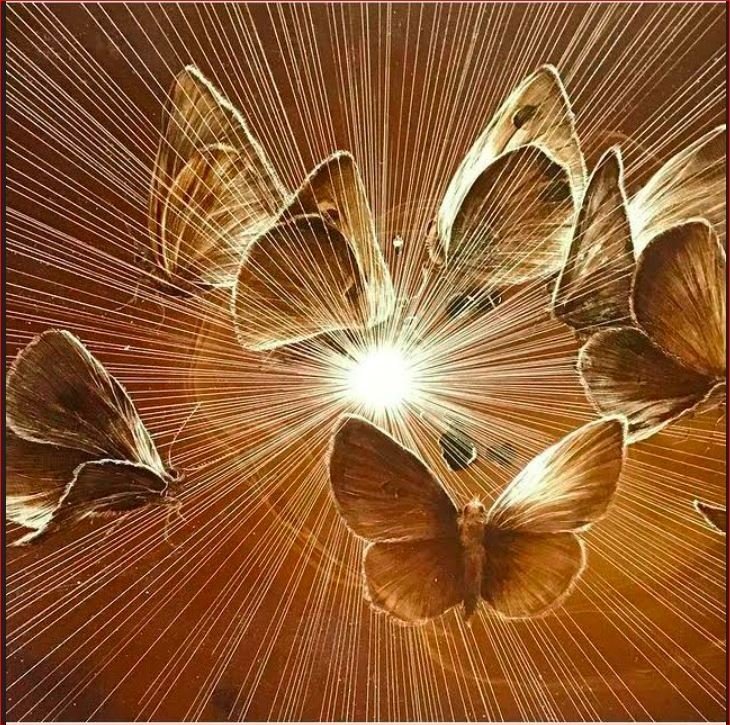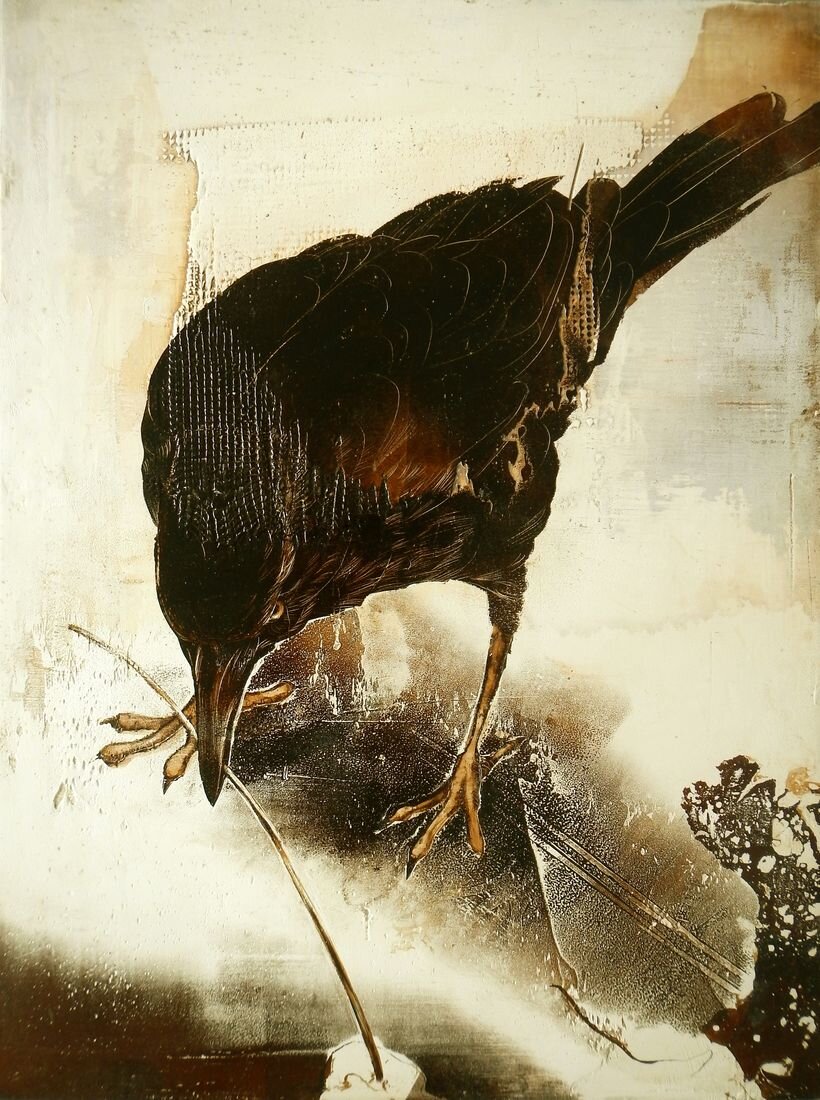Biophilia @ Craig Krull Gallery
MOUNTAIN LION, 2016. TAR ON PANEL. 16 X 12 INCHES. PHOTO: COURTESY OF CRAIG KRULL GALLERY
HUFFPOST
Lita Barrie, Contributor
Art critic: journalist, blogger and essayist
James Griffith’s innovative use of tar gives his nature paintings their own innate life. Griffith strives for economy by compressing complex ideas drawn from the histories of art and science. His skill-set knowledge - of painting, drawing and etching - reflect his love of the detailed craftsmanship of old masters, like Albrecht Durer. He is also inspired by 18th century science engravings of animals. Griffith’s process-oriented paintings are content-rich, because he applies restraint and precision to condense far-reaching ideas with the materiality of tar. Instead of depicting nature, Griffith works with nature itself, extracting images of the milky way, flora and fauna out of tar so that his paintings exude life. Rather than making paintings of nature Griffith’s artwork behaves like nature - recalling Jackson Pollock’s famous comment “ I don’t paint nature. I am nature.”
BEAR, 2016. TAR,OIL ON CANVAS. 72 X 42 INCHES. PHOTO: COURTESY OF CRAIG KRULL GALLERY
Griffith collects tar, with the permission of George C. Page Museum which opens the archaeological excavation site by appointment to give him buckets of this ancient petrochemical - which is a culturally loaded signifier. He says “When I dip my brush into the tar to paint I pull out a double-edged sword.” Griffith continues, “One edge, the fossil record, cuts back through time to our primordial origin story, while the other edge, the fossil fuel, cuts with the lethal power wrecking havoc in the environment. With one stroke of the brush, the tar tells two stories at once: one of our past and one of our present.”
Griffith views the La Brea Tar Pits as “a sacred site because it is a physical proof of evolution and extinction.” Griffith’s work has a strong sense place because it is made of tar collected from ”a portal to the primordial past of the planet” in the center of L.A.
OKAPU, 2016. TAR ON PANEL. 24 X 18 INCHES. PHOTO: COURTESY OF CRAIG KRULL GALLERY
Griffith crafts a language of tar using a three-part process. He explains, “One is the material, another is the image, and the third is the process that links the image to the materials.” The first step involves troweling white oil paint across a panel that allows accidental inflections and flaws to remain. Griffith says “the poetic of this process is to start with a surface which has a history.” The second step involves pouring water on the flat bed, followed by pouring a dilute mixture of tar into the water that allows the tar to speak through the chemical process. At this stage Griffith uses stencils made from his preparatory animal drawings. The third step involves an engraving process using tar as a scratchboard for creating finely detailed textures and forms with a knife. Griffith balances abstraction and representation, by capturing spontaneous events that occur with a brush, like a Sumi-e ink painter (another technique he studies). Griffith repeats these steps, adding more layers of white oil paint, tar or engraving to create an illusion of depth. When Griffith uses twirling tar to create galaxies, he references a Zen idea of painting a poem. But this honoring is undercut by the horror of what we are doing to the planet by burning fossil fuels.
CROW WITH TOOL # 5, 2017. OIL, TAR ON PANEL. 16 X 12 INCHES. PHOTO: COURTESY OF CRAIG KRULL GALLERY
Griffith creates an illusion of spatial depth from the range of light and dark effects that occur through the chemistry of tar - that recalls photography. As the son of a photographer, Griffith understands the way photography uses light. The sepia tones of tar also recall vintage photographs, creating an aura of antiquity. Griffith is also influenced by artists famous for using black and white light effects: from old masters like Francisco Goya and Rembrandt to contemporaries like Sigma Polke. Light effects and spatial depth are the main concern of many serious artists stretching back to the Renaissance. When Griffith pulls galaxies out of ancient tar he also captures the sui generis quality of Southern California where archaeological excavation and outer space exploration are simultaneous - which he relates to a time machine.
Interestingly, Griffith inhabits his vision of a planet where past and present meet with animals - rather than people. Griffith empathizes with these noble wild animals, imagining what it would be like to inhabit their body and look at the world through their eyes - rather than ours. His empathetic paintings accentuate the emotions in the eyes and stance of animals who occupy the center stage in a Darwinian drama. He paints dueling stags, wandering wolves, odd encounters between a horse and dog, a chicken and a rooster, a goat stretching against a lemon tree, a crow discovering a tool, a noble bear or an elephant announcing itself. Solitary animals scratch themselves and peer into the far distance in a world a privacy. Animals are also involved in the natural selection of push-me-pull-you and hunter-and-hunted relationships.
SWAN 2, 2016. OIL, TAR ON PANEL. 24 X 18 INCHES. PHOTO: COURTESY OF CRAIG KRULL GALLERY
Circular forms and swirls are recurrent leitmotifs in Griffith’s lexicon. Two birds fighting turn into a circular form or the beautiful curve of a swan’s neck or crane’s profile turns into a swirl. Detailed representation flows organically into abstraction. An elliptical form can fragment like a DNA molecule or like the milky way. Griffith creates a beautiful vision of the universe from primordial goo, to show that the complex chemicals of stars, our planet, and all wildlife on the planet, are the same.
LEMON TREE AND GOAT, 2016. TAR, OIL ON CANVAS. 60 X 48 INCHES. PHOTO: COURTESY OF CRAIG KRULL GALLERY
Exhibition Location: Biophilia @ Craig Krull Gallery. 2025 Michigan Ave, Building B3, Santa Monica, CA 90404 + 310.828.6410
Exhibition Dates: March 4 - April 8, 2017






